

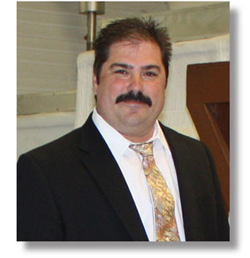
CI President Dennis Kowalski
Saturday, September 12th, CI will host both the Cryonics Institute and the Immortalist Society Annual General Meetings. I look forward to seeing old friends and hopefully making some new ones. We have continued our facilities improvements with a new conference/tribute room. This room will serve several purposes. First, it will be a place of tribute for families to pay respects to those who have gone into preservation before us. It is a place to honor the hard work and sacrifices of past members who have selflessly donated time and money to our mission. Second, it will serve as a meeting place for official business and conference calls. Third, it will be a comfortable place to educate visitors, media and members of the public who wish to learn more about cryonics. I am confident that those who see it will appreciate the upgrade and the appeal it lends to our facility.
It is also election time and we urge members to think seriously about the type of director they want representing their interests now and into the future. I myself take our voting very seriously and I look at what those running for office have done in terms of dedicating their own time and effort to make CI a better organization. As I mentioned in my last report, it is one thing to make suggestions, point out problems real or perceived, and another to actually be in the thick of it, putting forth your own time and money to make things happen. This is how I personally measure our directors, and also how I expect to be measured myself as CI President. We also have some exciting news to share about our new smart phone app that we will be introducing at the AGM. We talked about it last year and we are now just finishing beta testing with a launch date of approximately Sept 12th if all goes well. This application will hopefully mark an important first step in addressing the urgent need for early emergency notification both for Cryonics members as well as for anyone who wishes to have an automated system for checking in on a loved one who may be alone and in need of medical help. Some of our members live alone or are older, and from time to time experience health issues. In the past, we have talked about building a device to detect when a member needs help. Pulse detection and motion detection are two front running methods of setting off an emergency cryonics alert, however these technolgies can be both complicated and expensive to develop and deploy successfully.
The Cryonics Institute Emergency Check In app uses existing Android smart phone technology to provide our members with an inexpensive and effective early-warning solution. Once activated, the program will allow users to set a simple alarm check-in schedule based on their preferences. The alarm “checks in” to ask if you are all right several times during the day based on your selected schedule. If you don’t respond to the alarm after 10 minutes, the app sends an emergency text message to a pre-selected list of contacts indicating you might be in trouble and need help.
You can also use the system as an immediate panic button - for example, if you feel severe chest pains prior to a heart attack. If you should lose consciousness or even slip into cardiac arrest before you can hit the panic button, the device will auto-alert a local friend or family member to your situation. The app also features a cancel button for false alarms and can be switched on or off as needed based on your circumstances. There will be a small charge for the app and all money will go to improved versions and upgrades to the existing program. The CI Check-In app will be available on Google Play September 12.

We feel that this is an important first step toward addressing the serious problem of a member having a medical emergency, or even dying, alone where there is no one around to help. We hope that this app will be an important step toward addressing the longstanding problem of providing early notification for cryonics patients. As with most of what CI does, we are nonprofit and open source. Therefore, we are hoping that other cryonics organizations and their members will benefit from our new app as well. For this reason, we will be asking members to share this app with other cryonicists and even non-cryonicists who might like having a way to check in on family, friends and neighbors who may be older or in poor health. We expect later versions to have a GPS map component and compatibility with pulse detecting smart watches. If you don’t already have a smart phone this may be your reason to get with the program and upgrade. The more people who use the app the better it will become.
Best wishes, and I look forward to seeing you at this year’s AGM!
All CI members should have received their 2015 Board of Directors elections ballots in the mail. If you have not received your ballot, please contact CI Headquarters to resolve any issues. This year’s candidates for election follow in alphabetical order.

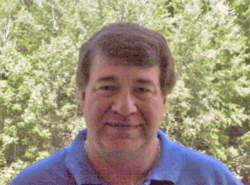

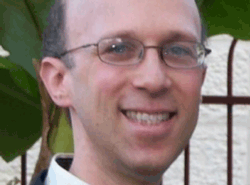
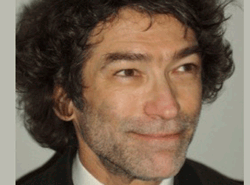
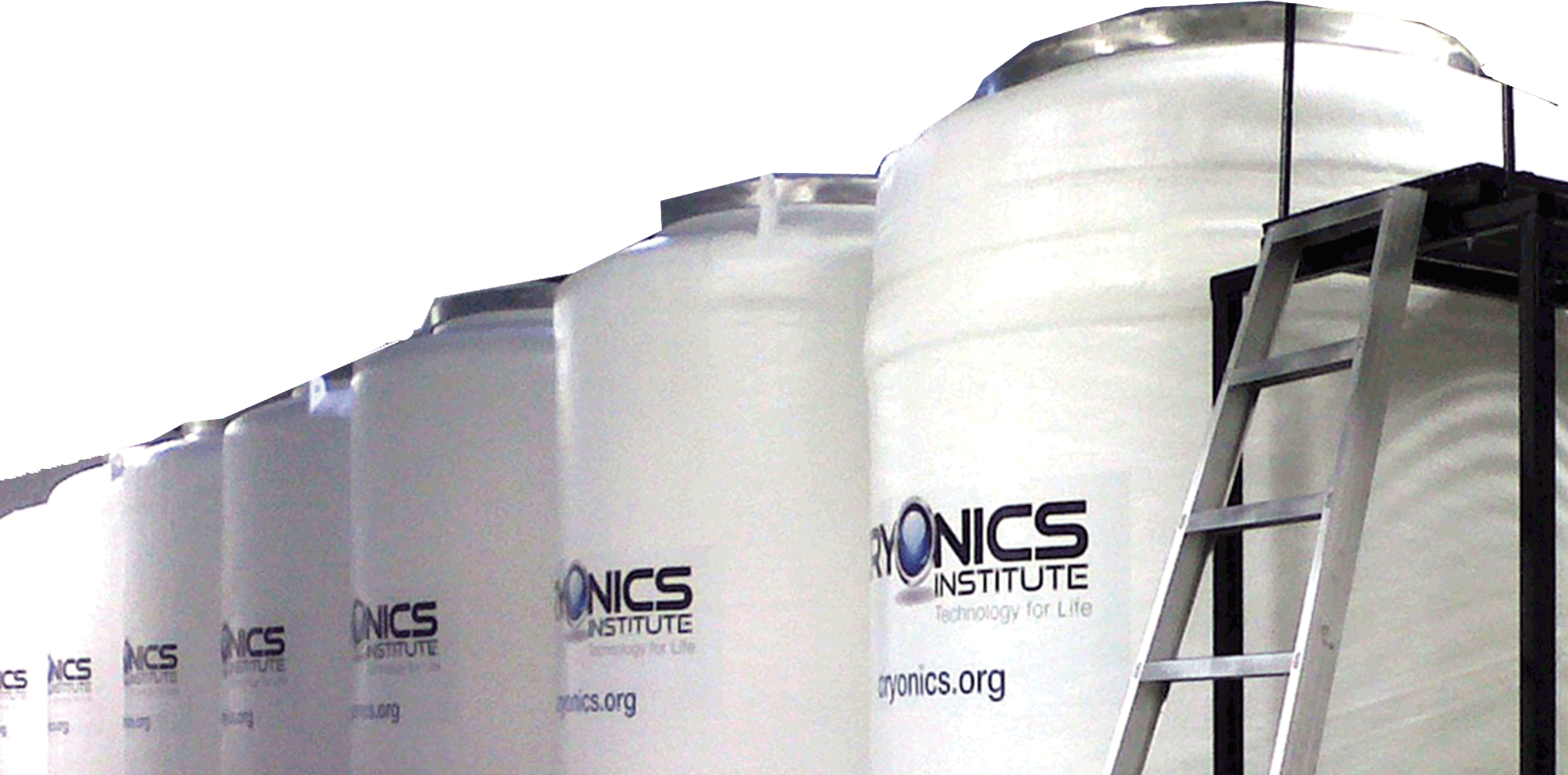
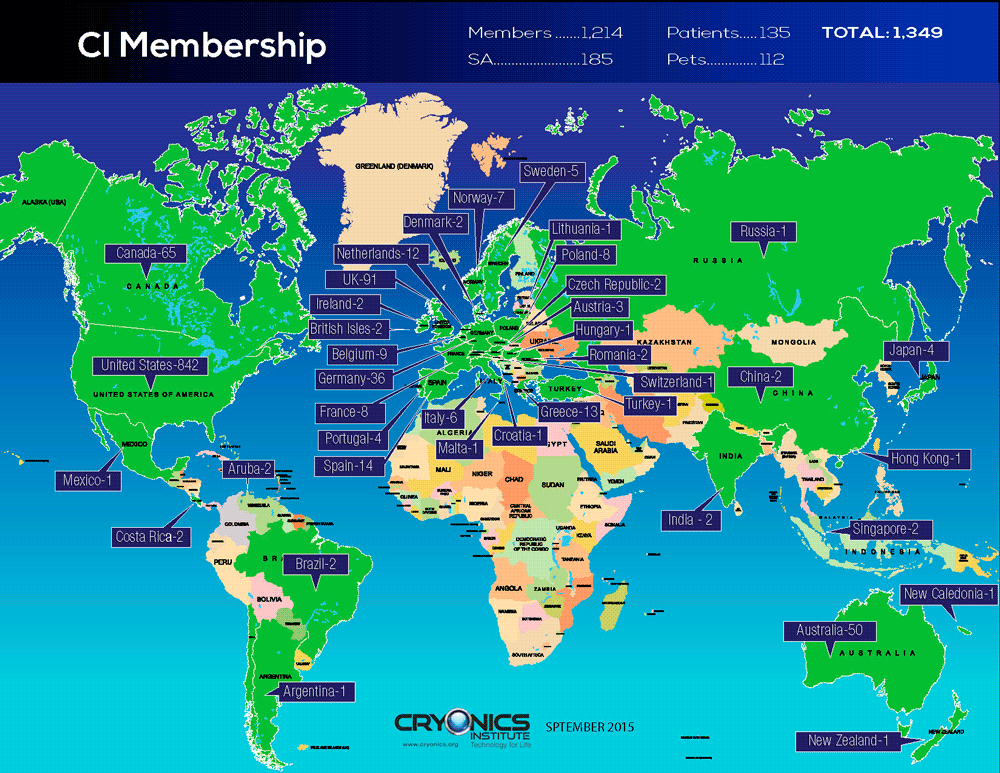
Every issue, we’ll be highlighting a single aspect of standby to provide our members with a simple incremental program for setting up their own standby arrangements. Proper standby arrangements can seem like an overwhelming task, so our goal is to help you by breaking down the process into “bite-sized” pieces that can each be easily accomplished in a reasonably short time with a minimum of effort. Some tasks will be more involved than others, but remember - in an emergency situation, even the smallest step taken today can prove to be a lifesaver tomorrow.
A critical aspect for a cryonicist in an emergency situation is simply notifying emergency personnel of your cryonics intentions when you’re not able to. Wallet cards are one solution. Another are special “File of Life” packets you can place on your refrigerator and in your vehicle. Packets include pre-printed color forms, vinyl display sleeves for each form, and File of Life notification stickers for your front door or drivers side window or glove compartment.
Statisitcally, a majority of emergency situations occur in one’s home or car, so these are great places to have medical and cryonics information visible and available.
File of Life sets are $5.00 for a funded member and $10 for a non-funded member to cover shipping and handling costs. To order, please contact cihq@aol.com. Please include your full name and mailing address.
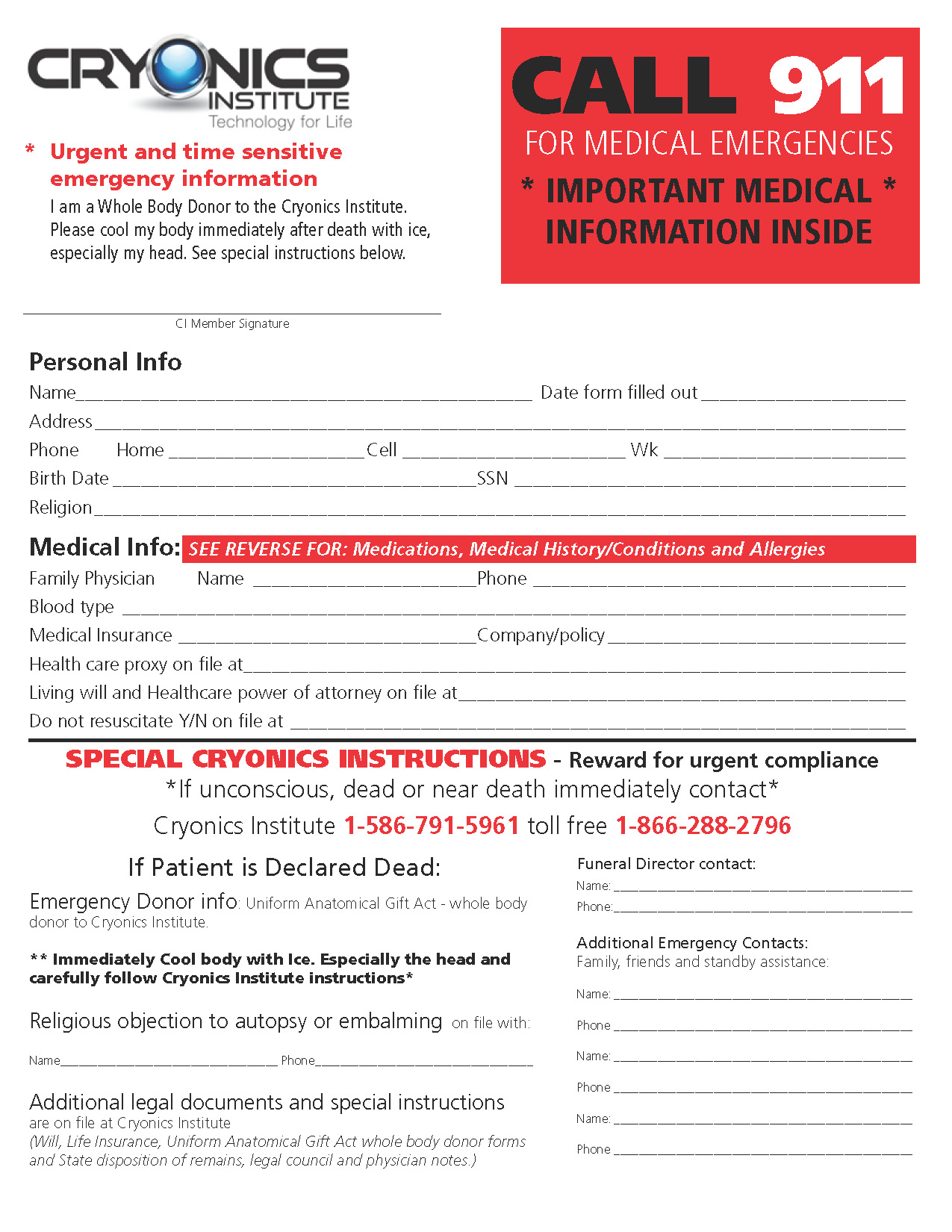


If you live in one of the countries listed, we’d appreciate if you would please take a moment to contact the groups listed in your country to confirm their details. Also, if you know of, or are considering starting a support, standby or other cryonics-related group in your area, please send details to cryonicsnews@gmail.com.
AUSTRALIA: The Cryonics Association of Australasia offers support for Australians, or residents of other nearby countries seeking information about cryonics. caalist@prix.pricom.com.au. Their Public Relations Officer is Philip Rhoades. phil@pricom.com.au GPO Box 3411, Sydney, NSW 2001 Australia. Phone: +6128001 6204 (office) or +61 2 99226979 (home.)
BELGIUM: Cryonics Belgium is an organisation that exists to inform interested parties and, if desired, can assist with handling the paperwork for a cryonic suspension. The website can be found at www.cryonicsbelgium.com. To get in touch, please send an email to info@cryonicsbelgium.com.
BHUTAN: Can help Cryonics Institute Members who need help for the transport & hospital explanation about the cryonics procedure to the Dr and authorities in Thimphou & Paro. Contacts : Jamyang Palden & Tenzin Rabgay / Emails : palde002@umn.edu or jamgarnett@hotmail.co Phones : Jamyang / 975-2-32-66-50 & Tenzin / 975-2-77-21-01-87
CANADA: This is a very active group that participated in Toronto’s first cryopreservation. President, Christine Gaspar; Vice President, Gary Tripp. Visit them at: http://www.cryocdn.org/. There is a subgroup called the Toronto Local Group. Meeting dates and other conversations are held via the Yahoo group. This is a closed group. To join write: csc4@cryocdn.org
QUEBEC: Contact: Stephan Beauregard, C.I. Volunteer & Official Administrator of the Cryonics Institute Facebook Page.
For more information about Cryonics in French & English:
stephanbeauregard@yahoo.ca
FINLAND: The Finnish Cryonics Society, (KRYOFIN) is a new organization that will be working closely with KrioRus. They would like to hear from fellow cryonicists. Contact them at: kryoniikka.fi Their President is Antti Peltonen.
FRANCE: SOCIETE CRYONICS de FRANCE Roland Missionnier would like to hear from cryonicists in Switzerland, Luxembourg and Monte Carlo, CELL: (0033) 6 64 90 98 41, FAX: (0033) 477 46 9612 or rolandmissonnier@yahoo.fr
Can help Cryonics Institute Members who need help for the transport & hospital explication about the cryonics procedure to the Dr and authority in Toulouse Area. Contact : Gregory Gossellin de Bénicourt / Email : cryonics@benicourt.com Phone : 09.52.05.40.15
GERMANY: There are a number of cryonicists in Germany. Their homepage is: www.biostase.de (English version in preparation.) if there are further questions, contact Prof. Klaus Sames: sames@uke.uni-hamburg.de.
INDIA: Can help Cryonics Institute Members who need help for the transport & hospital explication about the cryonics procedure to the Dr and authority in Bangalore & Vellore Area. Contacts : Br Sankeerth & Bioster Vignesh / Email : vicky23101994@gmail.com Phones : Bioster / 918148049058 & Br Sankeerth / 917795115939
ITALY: The Italian Cryonics Group (inside the Life Extension Research Group (LIFEXT Research Group)) www.lifext.org and relative forum: forum.lifext.org. The founder is Bruno Lenzi, contact him at brunolenzi88@gmail.com or Giovanni Ranzo at: giovanni1410@gmail.com
JAPAN: Hikaru Midorikawa is President Japan Cryonics Association. Formed in 1998, our goals are to disseminate cryonics information in Japan, to provide cryonics services in Japan, and eventually, to allow cryonics to take root in the Japanese society. Contact mid_hikaru@yahoo.co.jp or http://www.cryonics.jp.
NEPAL: Can help Cryonics Institute Members who need help for the transport & hospital explanation about the cryonics procedure to the Dr and authorities in Kathmandu. Contact : Suresh K. Shrestha / Email : toursuresh@gmail.com Phone : 977-985-1071364 / PO Box 14480 Kathmandu.
NETHERLANDS: The Dutch Cryonics Organization http://www.cryonisme.nl) is the local standby group and welcomes new enthusiasts. Contact Secretary Japie Hoekstra at +31(0)653213893 or email: jb@hoekstramedia.nl
* Can help Cryonics Institute Members who need help, funeral home, transport & hospital explication about the cryonics procedure to the Dr and authority at Amsterdam with branches in other cities. Contact : Koos Van Daalen / Phone (24 Hours) +31-20-646-0606 or +31-70-345-4810
NORWAY : Can help Cryonics Institute Members who need help for the transport & hospital explication about the cryonics procedure to the Dr, funeral home and authority at Sandvika. Contacts : Gunnar Hammersmark Sandvika Begegravelsesbyraa / Phones : 011-47-2279-7736
RUSSIA: KrioRus is a Russian cryonics organization operating in Russia, CIS and Eastern Europe that exists to help arrange cryopreservation and longterm suspension locally, or with CI or Alcor. Please contact kriorus@mail.ru or daoila.medvedev@mail.ru for additional information or visit http://www.kriorus,ru. Phone: 79057680457
SPAIN: Giulio Prisco is Secretary of the Spanish Cryonics Society. Website is http://www.crionica.org.sec. He lives in Madrid and he’s a life member of CI and is willing to serve as a contact point for Europeans. He can be contacted at: cell phone (34)610 536144 or giulio@gmail.com
SWITZERLAND:
www.CryonicsSwitzerland.com or www.ria.edu/cs
UNITED KINGDOM: Cryonics UK is a nonprofit UK based standby group. http://www.cryonics-uk.org Cryonics UK can be contacted via the following people: Tim Gibson: phone: 07905 371495, email: tim.gibson@cryonics-uk.org. Victoria Stevens: phone: 01287 669201, email: vicstevens@hotmail.co.uk. Graham Hipkiss: phone: 0115 8492179 / 07752 251 564, email: ghipkiss@hotmail.com. Alan Sinclair: phone: 01273 587 660 / 07719 820715, email: cryoservices@yahoo.co.uk
Can help Cryonics Institute Members who need help, funeral home, transport at London. Contact : F.A. Albin & Sons / Arthur Stanley House Phone : 020-7237-3637
INTERNATIONAL: The Cryonics Society is a global cryonics advocacy organization. Website is www.CryonicsSociety.org. They publish an e-newsletter FutureNews. Phone: 1-585-643-1167.


This image of the lab-grown brain is labeled to show identifiable structures: the cerebral hemisphere, the optic stalk, and the cephalic flexure, a bend in the mid-brain region, all characteristic of the human fetal brain (credit: The Ohio State University)
Read the full story at Kurzweilai.net
A study led by researchers at McMaster University has found that that trans fats are associated with greater risk of death and coronary heart disease, unlike saturated fats, which are also not associated with an increased risk of stroke or Type 2 diabetes.
Read the full story at Kurzweilai.net
The tantalizing but contentious claim that a material can conduct electrical current without resistance at temperatures as high as –70° Celsius has cleared another hurdle: It’s been published in a peer-reviewed journal. A study published August 17 in Nature provides multiple lines of evidence that pressurized hydrogen sulfide is the highest temperature superconductor ever discovered.
Read the full story at Sciencenews.org
New research could one day help build computers from DNA. Scientists have found a way to ‘switch’ the structure of DNA using copper salts and EDTA (Ethylenediaminetetraacetic acid) -- an agent commonly found in shampoo and other household products. The applications for this discovery include nanotechnology -- where DNA is used to make tiny machines, and in DNA-based computing -- where computers are built from DNA rather than silicon.
Read the full story at Sciencedaily.com
Welcome Aboard! You have taken the first critical step in preparing for the future and possibly ensuring your own survival. Now what should you do? People often ask “What can I do to make sure I have an optimal suspension?” Here’s a checklist of important steps to consider.
Become a fully funded member through life insurance or easy pre-payments
Some members use term life and invest or pay off the difference at regular intervals. Some use whole life or just prepay the costs outright. You have to decide what is best for you, but it is best to act sooner rather then later as insurance prices tend to rise as you get older and some people become uninsurable because of unforeseen health issues. You may even consider making CI the owner of your life insurance policy.
Keep CI informed on a regular basis about your health status or address changes. Make sure your CI paperwork and funding are always up to date. CI cannot help you if we do not know you need help.
Keep your family and friends up to date on your wishes to be cryopreserved. Being reclusive about cryonics can be costly and cause catastrophic results.
Keep your doctor, lawyer, and funeral director up to date on your wishes to be cryopreserved. The right approach to the right professionals can be an asset.
Prepare and execute a Living Will and Power of Attorney for Health Care that reflects your cryonics-related wishes. Make sure that CI is updated at regular intervals as well.
Consider joining or forming a local standby group to support your cryonics wishes. This may be one of the most important decisions you can make after you are fully funded. As they say-”Failing to plan is planning to fail”.
Always wear your cryonics bracelet or necklace identifying your wishes should you become incapacitated. Keep a wallet card as well. If aren’t around people who support your wishes and you can’t speak for yourself a medical bracelet can help save you.
Get involved! If you can, donate time and money. Cryonics is not a turnkey operation. Pay attention and look for further tips and advice to make both your personal arrangements and cryonics as a whole a success.
Keep up to date! Read CI Magazine and follow the simple “STANDBY WORKBOOK” exercise in each issue.
Welcome Aboard! You have taken the first critical step in preparing for the future and possibly ensuring your own survival. Now what should you do? People often ask “What can I do to make sure I have an optimal suspension?” Here’s a checklist of important steps to consider.
Membership qualifies you to arrange and fund a vitrification (anti-crystallization) perfusion and cooling upon legal death, followed by long-term storage in liquid nitrogen. Instead of certain death, you and your loved ones could have a chance at rejuvenated, healthy physical revival.
The Cryonics Institute (CI) offers full-body cryopreservation for as little as $28,000.
Become a Lifetime Member for a one-time payment of only $1,250, with no dues to pay. Or join as a Yearly Member with a $75 inititation fee and dues of just $120 per year, payable by check, credit card or PayPal.
The cost of a Lifetime Membership for a spouse of a Lifetime Member is half-price and minor children of a Lifetime Member receive membership free of charge.
CI employed a Ph.D level cryobiologist to develop CI-VM-1, CI’s vitrification mixture which can help prevent crystalline formation at cryogenic temperatures.
CI’s use of Locally-Trained Funeral Directors means that our members can get knowledgeable, licensed care. Or members can arrange for professional cryonics standby and transport by subcontracting with Suspended Animation, Inc.
Cryopreservation with CI can be funded through life insurance policies issued in the USA or other countries. Prepayment and other options for funding are also available to CI members.
Members have access to both the Cryonics Institute Newsletter and Long Life Magazine online, as well as our Facebook page, member forums and more.
CI offers a sampling kit, shipping and long-term liquid nitrogen storage of tissues and DNA from members, their families or pets for just $98.
Membership fees help CI to fund important cryonics research and public outreach, education and information programs to advance the science of cryonics.
CI Members are the ultimate authority in the organization and own all CI assets. They elect the Board of Directors, from whom are chosen our officers. CI members also can change the Bylaws of the organization (except for corporate purposes).
The choice is clear: Irreversible physical death, dissolution and decay, or the possibility of a vibrant and joyful renewed life. Don’t you want that chance for yourself, your spouse, parents and children?

CI is the world’s leading non-profit cryonics organization, bringing state-of-the-art cryonic suspensions to the public at the most affordable price. CI was founded in 1976 by the “father of cryonics,” Robert C.W. Ettinger as a means to preserve life at liquid nitrogen temperatures. As the future unveils newer and more sophisticated medical nanotechnology, it is our hope that the people preserved by CI may be restored to youth and health.
One of our goals for the CI Newsletter is to provide a forum for member outreach and opinion in addition to the existing online forums. If you have comments to share, feel free to write us at cryonicsnews@gmail.com. We may introduce a letters column if response is favorable, so if you do write, please indicate if your letter is approved for publication or not.
The CI Newsletter is looking for submissions from our readers! If you’ve got a great idea for a story, please forward it to: cryonicsnews@gmail.com.
We’re looking for your suggestions on subjects like the sign-up process, communications and other aspects of being a CI member.
Members' TalkEditor’s Note: Our last question was a bust, and a few members indicated they weren’t comfortable with having their names published. Please note, answers will be published anoymously unless you give permission to use your name. We’d like a feature in the newsletter to share members comments on cryonics and CI, so we’re hoping this question generates more results!
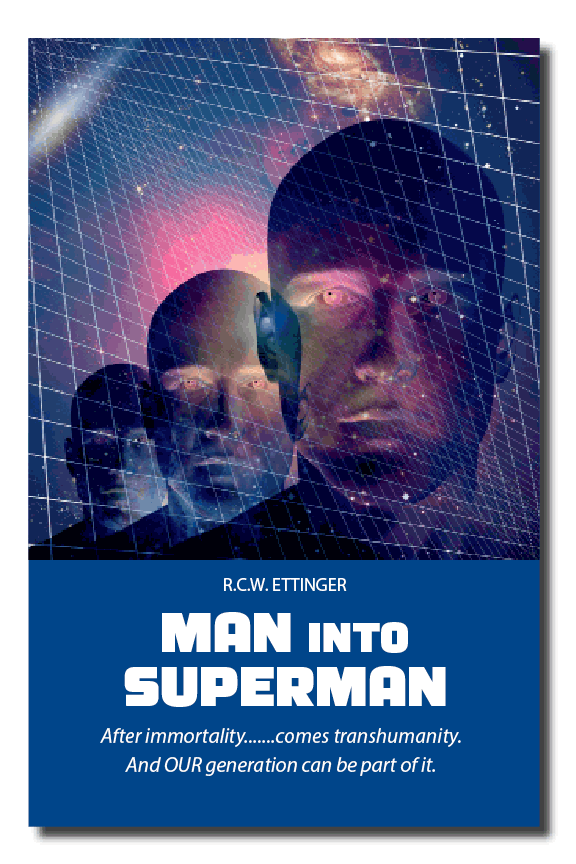
What is wrong with Man? Nothing much, really, say the apologists. In their view, God or Nature has designed mankind perfectly, with imperfections found only in individual men, attributable to defects of character or training, or to some variety of sin, or to luck.
Some say further that the human potential, with the existing genetic basis, is virtually unlimited: man’s brain is a treasure chest to which we need only find the right key. After all, they point out, man’s biological nature has been almost unchanged for at least fifty thousand years. (There is some disagreement; Sir Peter B. Medawar tells us there is some slight evidence that color vision is younger than humanity, and may even have originated in historic times.) (118) It is likely that if a baby from the caves of Cro-Magnon could somehow be transported forward in time and reared in New York, he would be indistinguishable from a modern child. Although his native culture had, for example, no mathematics or written language, that child was born with the capacity to learn to read and cipher. All the elements of modern technology were already nascent in those simple
hunters and gatherers; implicit in their neurology were the electronic computer and the hydrogen bomb; somehow evolution had already prepared them to be astronauts.
Even today, it is said, we use only a small fraction of our brain capacity. Hidden in those convolutions, some believe, are capabilities yet untapped or even unimagined; our task is not to become superhumans but to become fully human. Possibly even our bodies would function optimally, if only we gave them proper treatments
Out of such ideas have sprung long successions of fads and philosophies, communities and movements. Some of the still active ones include yoga and vegetarianism, general semantics and scientology, dervishism and organic farming. Devotees of these systems find no fault with our nature; incorrect nurture is our problem.
If such ideas have much merit, then there are dangerous pitfalls indeed in any attempt to design new men. Fooling around with the circuitry of the brain for instance, we might build an improved memory, but destroy, all unknowingly, the capacity for mental telepathy Perhaps, even, our design is aimed at a superculture we have not yet grown up to, and clumsy attempts to improve the short-run lot of the individual will abort this development.
Maybe so—just maybe. There is a need for caution in tampering with what we don’t understand. When we have achieved immortality, perhaps we will decide to go very slowly in innovating “improvements”. On the other hand, it is difficult to be patient with our cheap bodies, erratic emotions, and feeble mentalities; when we learn how to make improvements with apparent safety, some people will choose to do so, and probably most others will soon follow.
The objections are largely vitiated anyhow by the failure of their two main implicit premises: (1) that the race is more important than the individual; (2) that mistakes are irreversible. Anyone who believes the first is slightly insane: of this, more later. As to reversibility, this would usually be a question of time and money and immortals would tend to have both.
It is still necessary to clarify the need for superman by making explicit some of the defects of man, especially his racial insanity, his built-in psychoses. To see our mental defectiveness in a biological frame of reference, it is useful first to look at the crudities and contradictions of our physical construction; and it is helpful to precede this, in turn, by a glance at the lower orders.
“History is more or less bunk,” said Henry Ford I, and nearly everybody seems to believe it. Not only written history, but paleontology and natural history hold lessons which are regularly ignored.
The second lesson of paleontology (discussion of the first being deferred as too personal and painful) is that nature does slipshod work in designing her creatures, whose adaptations to environment are always partial and temporary. Life on earth spans at least two billion years and millions of species; of all those species, 99.9%. have become extinct, and both the coming and the going of a species is a torment. In our own times, as one small example, the marsupial wolf has died out in Australia, owing to the competition of the dingoes which are superior hunters. The poor, great, clumsy marsupials slowly starved, together with their young, as the dingoes usurped the game.
Was there ever a marsupial Camelot? Was there one brief, shining geological era in which the marsupial wolves waxed fat and happy and lived in harmony with their en-vironment? Hardly--unless “harmony” includes internal and external parasites from ticks and ringworms to bacteria and viruses; unless it includes bullying and being bullied in establishing a ranking order; and unless it includes the frequent loss of young to sly predators; etc.
Even during the heyday of a species, its “success” generally represents the most pyrrhic of victories. Mosquitoes and frogs do splendidly as species--at the expense of the individual, who has only a minute chance of surviving the larval or tadpole stage respectively; the majority meet their destinies very quickly as fish food. The drone bee has a short life and a very small chance to mate; the queens and workers seem hardly more enviable, although we know nothing of their subjective life. In some kinds of spiders, the female eats the male during the act of copulation. (This doesn’t prove anything, but it gives us some perspective on what is “natural.”) Neanderthal man may have done fairly well for a while, but if he survived to middle age, he usually wound up with arthritis or some other chronic ailment, as studies of his remains have shown.
By no means are all the miseries of a species the unavoidable result of competition and predation in any simple sense; some represent plain goofs of nature, or costly compromises. Some insects will fly into flames; horses are said sometimes to run back into burning barns. While these traits may be related to others that do have survival value, they are certainly maladaptive in themselves. Indeed, most traits show up maladaptive in some circumstances; certain cichlid fish, which normally vent their aggression on hostile neighbors, will rend their mates if there is nothing else to attack. (104)
With almost complete generality, the lower orders are flawed and botched, and we can expect the same to be true of man.
The purely physical shortcomings of the human animal are legion, and we need only tick off a few, most of them well known.
The worst weakness of all, of course, we share with every other large animal: the susceptibility to degenerative disease, senile debility, and death from old age. A less critical, but still serious, defect is our manner of gestating and bearing children, which represents not only inconvenience but danger to the mothers. If some of us temporarily choose to regard these as “natural,” there are plenty of others that are clearly pathological.
Our skeletons and internal organs are only partly adapted to our relatively recent upright posture, as our backaches and fallen arches often attest. Our responses to sickness and injury are only sometimes appropriate, e.g., fever, which is a nearly universal response to infection, is an effective defense against only a few diseases, and is usually harmful, which is why we take aspirin. There appears to be no useful basis for the shock syndrome that usually accompanies trauma, one of its main features being dangerously or fatally reduced blood pressure. (It might conceivably be helpful in some bleeding cases, but not usually.) And everyone knows that the vermiform appendix is not only useless, but a dangerous locus of potential infection.
Again, consider the body’s response to foreign protein. In the words of Dr. Medawar:
Vertebrate animals evolved into the possession of immunological defenses long before the coming of mammals. Mammals are viviparous: the young are nourished for some time within the body of the mother and this (in some ways) admirable device raised for the first time in evolution the possibility that a mother might react immunologically upon her unborn children--might treat them as foreign bodies or as foreign grafts. The hemolytic disease that occurs in about one new-born child in 150 is an error of judgment of just this kind: it is, in effect, in immunological repudiation by the mother of her unborn child. Thus the existence of immunological reactions has not been fully reconciled with viviparity; and this is a blunder--the kind of blunder which, in human affairs, calls forth a question in the House, or even a strongly worded letter to The Times. (118)
Anaphylactic shock, allergy, and hypersensitivity are other aberrations of the immunological process. Now, it might be argued that not everyone shows these bad reactions, hence the ideal man exists at least potentially in present-day humanity, perhaps even actually (in very small numbers); but this is a poor argument, and not only for reasons already given.
Does it seem unfair to look on susceptibility to infectious disease as a racial defect? A better perspective on this question, and on the statement in the preceding paragraph, is given by considering the devilish phenomenon of sickle- cell anemia. This is a disease which usually causes early death in one quarter of the children of parents of a certain blood type that confers high resistance to malaria. This is the devilish part: either you (or your wife) are vulnerable to malaria, or one fourth of your children will probably die of anemia.
The apologist maintains that, in every deplorable case, either the individual or the local environment is “abnormal.” Well, it might be possible, after a number of generations, by purely eugenic methods to breed a race from present stock which will be free of disease (other than senile degenerative disease) in some carefully chosen environment. But most of us would have no part in this, and even then, viability would depend on continuance of the special environment. There is really no evading the fact: our species is in many respects, and possibly in most respects, physically abnormal.
Life—as we used to say erroneously about nature--abhors a vacuum; it will creep into every nook and cranny that offers the least hospitality. Let the smallest ecological niche appear, and presto--some form of life has adapted to it and claimed it, moved in bag and baggage. This is all very clever and enterprising, but not much fun for the organisms involved; adaptation is grim business.
We don’t know anything about the feelings, if any, of the common house fly, so we can’t truly say whether they enjoy their early lives as larvae in the garbage cans they inhabit. Neither can we say whether tapeworms or body lice are thankful for their existence. But we can be fairly sure that the ancestors of the woolly mammoths were pretty uncomfortable in their adaptation to the advancing ice; and the wooly mamoths themselves were even more uncomfortable when the ice receded, since they became extinct.
Many humans also have adapted to “life in the garbage can,” although we cannot yet be sure how much of the adaptation is genetic and how much cultural. Aggressiveness pays off for conquerors, but for the conquered, the needed trait is submissiveness. One might speculate, for example, as to the genetic nature of the Untouchable class in India, who for many generations have had to live off the leavings, and accept the abuse, of the higher castes. Have they become a genuine biological sub-species or variety, servants bred and born? One is tempted to guess this, based on our experience, for example, with breeding varieties of dog, which certainly differ in temperament.
There is much danger and uncertainty in attributing hereditary character traits to human groups. For instance, British historian E. R. Bevan, writing about the stormy and aggressive nature of the ancient Hebrews, remarks “We must not indeed conceive the Jews of those days as like the Jews of Medieval Europe, an unwarlike people given to sedentary pursuits and the handling of money. It was the policy of the. Christian Roman Empire which barred to the Jews the profession of arms, and produced the type commonly regarded in later times as Jewish.To picture the bands of Judas Maccabeus we should not think of the Jews of Medieval and modern times, but of people more like the fierce monotheistic ghazis of the Indian frontier-Afghans and Pathans.” (13) He apparently thought centuries of losing had bred warrior aptitudes out of the Jews, and would have been astonished to see the Jews of modern Israel, despite great disadvantages in numbers and equipment, kicking the tar out of all comers. Conceivably the Untouchables also have such latent resources, although there are important differences: in particular, the Indians apparently accepted their lot, while the Jews always believed in their own superiority and never dammed up their aggressiveness but only diverted it, when necessary, into different channels (This also exacted its price, however, and the adjustments were very abrasive.)
Regardless of the validity of particular examples, it is obvious that there must exist species and varieties which are abnormal and miserable. Growth and population pressures tend to force life into every available niche, and while the adapting life form tries to make a virtue of necessity, success is usually very incomplete. Biological “success” does not require happiness, or comfort, or even the absence of the most wretched misery, if the primitive drives are strong enough. The process of adaptation can be excruciating for an entire species--and after all that struggle, when one is well settled in the garbage can, something is likely to move the can or start throwing in the wrong kind of garbage, and it has all to be done over again.
To some degree, we all live in the garbage can, and the lesson, once again, is that we must never be complacent about accepting the “natural order” of things.
We are trying to dispel the superstition that man’s psyche is “normal” in some important sense, that it would blossom in beauty if only we could find the right milieu of spiritual sun and soil. There is no such milieu, and cannot be, as long as man remains himself. It is easy to show that man’s instincts, emotions and motivations are not only accidental, but mutually inconsistent.
Our first impulses are to feed, fornicate, and flee at need or opportunity. Some scholars would add a fourth--”fight;” they believe a generalized aggressive impulse is part of our basic nature. Professor Konrad Lorenz, director of the Max Planck Institute for behavioral physiology, thinks that aggression, in man and other species, is a true instinct, that represents “appetitive” behavior--we hunger to fight other people, just as we hunger for food, because intraspecific aggression (within the species) had evolutionary forces working for it. He writes:
(Man has) in his heart the aggression drive inherited from his anthropoid ancestors . . . the aggression drive is a true, primarily species-preserving instinct . . . it is the spontaneity of the instinct that makes it so dangerous. ... The completely erroneous view that animal and human behavior is predominantly reactive and that, even if it contains any innate elements at all, it can be altered, to an unlimited extent, by learning, comes from a radical misunderstanding of certain democratic principles. . . . The fact that the central nervous system does not need to wait for stimuli like an electric bell with a push-button, before it can respond, but that it can itself produce stimuli which give a natural, physiological explanation for the “spontaneous” behavior of animals and humans, has found recognition only in the last decades.... (104)
Dr. Lorenz’ interpretations of his fascinating observations are not always convincing, and are vigorously disputed by many scientists. Not all of us will accept as representative the dictum of Genghis Khan: “The greatest pleasure in life is to see your enemy in the dust before you, and to put your foot on his neck.” But it cannot be reasonably disputed that we have strong and strongly inherited tendencies that are equivalent, in sum, to a headful of violent and frequently antagonistic instincts and emotions. That some of our instincts are derivative and relatively newly risen does not weaken their force nor change the fact that they can often override the supposedly more basic drives.
A minor but convincing example of an autonomous instinct is that of sucking in infants,.It is obviously related to the feeding instinct, in its origin, but it is not the same; it has acquired a separate, independent status. The baby needs to suck, and wants to suck, and if its stomach is filled too quickly, will continue sucking motions until its appetite for sucking - distinct from its appetite for food - has been temporarily satisfied.
One of the most important and troublesome of our latter instincts, or endogenous drives, is the tendency to idealism, or zealotry or fanaticism. or what Lorenz calls “militant enthusiasm,” of which he writes:
Like the triumph ceremony of the greylag goose, militant enthusiasm in man is a true autonomous instinct: it has its own appetitive behavior, its own releasing mechanisms, and, like the sexual urge or any other strong instinct, it engenders a specific feeling of intense satisfaction. The strength of its seductive lure explains why intelligent men may behave as irrationally and immorally in their political as in their sexual lives. (104)
Of course, ideas of what is “irrational” or “immoral” in this context need to be made explicit, as they have not been by Lorenz. We shall discuss similar ideas, from a slightly different point of view, in Chapters 6 and 7. But it should be very clear that we are full of warring impulses, with no fixed ranking of priority, and that Lorenz’ “parliament of instincts” can by no means be depended upon to produce a satisfactory compromise
The idealist, humanists et al may insist that, regardless of instinctual elements in our psyches, it is possible to rise above them by an effort of will, or by appropriate early training. Besides other shortcomings, such notions exaggerate the importance of nurture vs. nature.
It is a very strong presumption that there are rather sharp limits on what can be done by purely educational and training techniques. Certain “progressive” educators have claimed that they can make almost any child into virtually anything, if they catch him early enough. Still, one doubts that even the most skillful teacher can train a dog to do calculus (although a colleague of mine at Highland Park College claims he has taught his German Shepherd to do quadratic equations), and probably few children, however devotedly coached, could become competent mathematicians, or generals, or surgeons, or bankers. As for purely moral and emotional aspects of training, these probably represent problems that are more difficult, not less.
A pig cannot fly, and however conscientiously he may diet, however he may direct his mind to lofty thoughts, he just isn’t going to get off the ground--as long as he remains a pig: and neigher is his swinish temperament going to become angelic, or even human, however firmly or tenderly we teach him. Man, also, is both limited and confused in his fundamental nature; the confusion of poorly reconciled instincts and emotions amounts to racial psychosis, a kind of built-in schizophrenia. The evidence is very strong that there is no cure-as long as we remain human.
By now it should be clear that man is an accident, not only his body but his psyche a patchwork of makeshift adaptive compromises. His attributes do not fit any apparent grand design or rational blueprint, but represent only the current, tentative result of the endless tugging and hauling of evolutionary forces, including random elements and self-contradictions.
It is said that in eighteenth-century France--and in twentieth-century India--beggar parents sometimes put out the eyes of their children, or cut off their hands, to make them more effective as alms-seekers. Possibly these child-mutilators were “right;” perhaps their chances of life, or the family’s, were improved by these cruel “adaptations.” But it is only in the same sense that Mother Nature was “right” in designing our insanities and inconsistencies; we, or our ancestors, were thereby made “fit,” as individuals or communities, to survive in the savage and merciless world of nature--for a while. Among our psychic mutilations, it is reasonably clear, are our tendencies to servility and submissiveness, which have their uses but nevertheless oppose and degrade the more basic traits of self-assertion and aggression; and our tendencies to zealotry and self-sacrifice, similarly opposed to the rationally preferable inclinations toward self-interest and self-preservation.
In sum, then, man--along with every other creature--can be considered only a beginning and a dubious compromise, in both mind and body. In the course of “natural” development, he might or might not eventually attain a higher and more harmonious state; but the race cannot depend on that, and the individual cannot wait for it. We must remake ourselves, and in planning for this we might begin by looking at previous speculations, the supermen of literature.In sum, then, man--along with every other creature--can be considered only a beginning and a dubious compromise, in both mind and body. In the course of “natural” development, he might or might not eventually attain a higher and more harmonious state; but the race cannot depend on that, and the individual cannot wait for it. We must remake ourselves, and in planning for this we might begin by looking at previous speculations, the supermen of literature.
open-ended future may mean a month wandering the Canadian wilderness, a winter basking on Pacific beaches, a year listening to Bach and Mozart, or Simon and Garfunkel. La dolce vita can become cloying or even disgusting, but some things are likely to wear well: soft grass, a fresh breeze, fleecy skies, a cool drink, crisp snow, a warm hand, a familiar voice—can a thousand years of these be too much?
Other likely rewards are just as tangible. Doubtless the day will come when every citizen will receive a basic income of $10,000,000 or more a year just for breathing, and millions more for such onerous tasks as jury duty. As Benjamin Franklin said, “There is no substitute for luxury,” and we can look forward with unabashed eagerness to an era when luxury will be taken for granted as the natural perquisite of every superman who wants it.
Unhappily, grateful and graceful acceptance of better things is not commonplace in the present age of confusion and warped personalities. Eleanor Roosevelt was reportedly baffled by the sweepers of India, who worked bent over all day with short-handled brooms, and could not be persuaded to save their backs by putting longer handles on the brooms. Today there are vast segments of the world population that will not concede it is better to be rich than poor, better to be bright than dull, better to be strong than weak, better to he free than regimented, or even that it is better to live than to die.
As for the possibility and necessity of redesigning ourselves and outgrowing our humanity, which ought to be nearly self-evident, one finds on every side the most solemn and long-winded arguments to the contrary. Hence, perhaps we had best begin with some brief reminders that it is indeed possible for people to design better people.
NEXT ISSUE:
CHAPTER THREE:
From Gilgamesh to Olaf Stapledon
If you know someone who might be interested in cryonics, share our newsletter:
NEWSLETTER SHARE